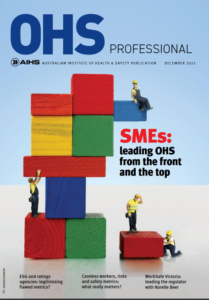Chain of Responsibility and the road transport industry, like many professions, has it’s own language and terminology. All of which which makes perfect sense in our world, but can be confusing to those who are new to the field. As a health and safety professional, I am guilty of this, although being conscious of it, I try to translate my ‘health and safety speak’ back to normal speak – for example, instead of talking about ‘identifying hazards’, it’s more engaging to ask – ‘what can go wrong here, how can people get hurt?’.
When I first started working in transport, everyone seemed to know what they were talking about (except me) but I decided to wait to pick it up rather than ask. That was things like – LCL (less than a container load), FCL (full container load), FAK (freight of all kinds), PE (personal effects), TEU (Twenty Foot Equivalent Unit).
Instead of talking about ‘identifying hazards’, it’s more engaging to ask – ‘what can go wrong here, how can people get hurt?’
Heavy Vehicle Regulation has its own set of acronyms and abbreviations that are commonly used, even in the Law and Regulations, so below is a table with explanations of some of the abbreviations you will commonly see.
Table 1. Common Chain of Responsibility Abbreviations
| Abbreviation | For | What This Does |
| HVNL | Heavy Vehicle National Law | The Heavy Vehicle National Law (HVNL) is the law that regulates all vehicles over 4.5t GVM in participating jurisdictions in Australia. The purpose of this law is to promote and support the safe and productive transport of goods and people by heavy vehicles. Read more about the HVNL |
| NHVR | National Heavy Vehicle Regulator | This is the statutory authority that administers the HVNL. The question we all want to know is why is one called the Heavy Vehicle National Law and the other the National Heavy Vehicle Regulator? |
| PBS | Performance Based Standards | These are design standards for heavy vehicles to be able to carry a heavier payload. The standards refer to the vehicle components, which are developed by engineers and very technical. |
| CoR | Chain of Responsibility | CoR recognises the on-road effects of actions, inactions and demands of off-road parties in the transport and supply chain, and provides for their accountability. |
| NTC | National Transport Commission | The NTC is an independent statutory body that contributes to the achievement of national transport by developing regulatory and operational reform of road, rail and intermodal transport |
| IAP | Intelligent Access Program | Satellite tracking and wireless communication technology to remotely monitor where, when, and how heavy vehicles are being operated on the road network. |
| LCL | Less than a Container Load | A consignment that is less than a full container |
| FCL | Full Container Load | A consignment that takes up a full container |
| FAK | Freight of All Kinds | Pretty self-explanatory – consignments of anything and everything |
| PE | Personal Effects | When people ship personal belongings – bikes, beds, furniture, clothing etc. |
| TEU | Twenty Foot Equivalent Unit | This is a measure for shipping containers. A 20 ft container is one TEU. A 40 ft container is 2 TEU. One 40ft container and 2 20 ft containers would be 4 TEU |
| Box | A shipping container |
We hope that you have found this information useful. Please get in touch with CoR Comply if you have any questions.






